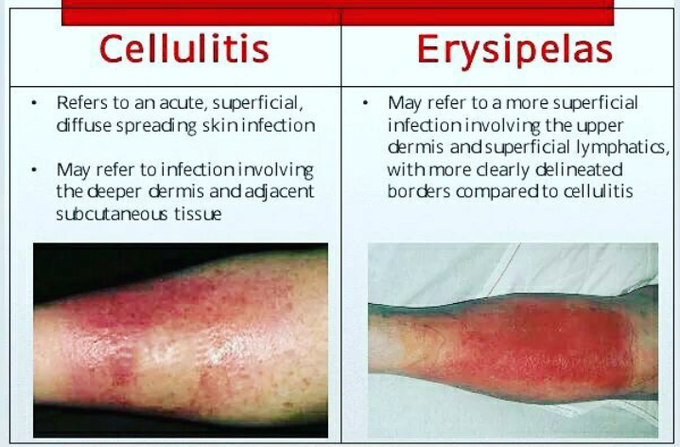


Cellulitis vs erysipelas
Erysipelas and cellulitis are infections of the skin. Erysipelas is a superficial infection, affecting the upper layers of the skin, while cellulitis affects the deeper tissues. They can overlap, so it is not always possible to make a definite diagnosis between the two. bacteria spreading. What are Cellulitis and Erysipelas? Though not quite the same, cellulitis and erysipelas are understood as one of the same condition. Both terms refer to a bacterial skin infection which can be very dangerous and if left untreated, life-threatening. The only difference between the two is in that erysipelas has sharp borders as opposed to cellulitis which is characterised by poorly defined borders. Also, erysipelas is more superficial and is most likely to affect the face, while cellulitis usually affects the legs - typically only one. What Causes Cellulitis and Erysipelas? Both cellulitis and erysipelas are caused by a bacterial infection. A number of bacteria can trigger these skin conditions but in most cases, the infection is caused by Streptococcus or Staphylococcus bacteria. What are Symptoms of Cellulitis and Erysipelas? With the exception of the differences mentioned above, both cellulitis and erysipelas can cause the following signs and symptoms: skin rednesspainswellingwarmth and tendernessfever If left untreated, these symptoms can get worse. Redness and swelling can expand to other areas, and as the infection spreads, the pain becomes more severe. Small red spots and rarely, blisters may form as well. Without medical help, the infection can spread to the bloodstream and lymph nodes, and cause life-threatening complications. As mentioned above, the infection most often affects the limbs (cellulitis) and face (erysipelas). Who is at Increased Risk of Cellulitis and Erysipelas? Cellulitis and erysipelas can affect anyone but there are some risk factors that put some groups at increased risk of developing this potentially very dangerous skin infection. They include: Compromised immune system. People with a weakened immune system - either due to an underlying medical condition or use of certain medications - are automatically more vulnerable to infections. Having a cut, burn or wound on the skin. Any form of break on the skin makes it easier on the bacteria to enter and multiply, and consequently, cause an infection. Certain conditions and skin diseases/disorders. These include diabetes, lymphedema (swelling of arms and legs), dermatitis, athlete’s foot and shingles. Other. Risk factors for cellulitis erysipelas also include obesity, intravenous drug use, alcoholism, insect bites and history of cellulitis. How are Cellulitis and Erysipelas Treated? Cellulitis and erysipelas require prompt treatment with antibiotics to prevent complications.


